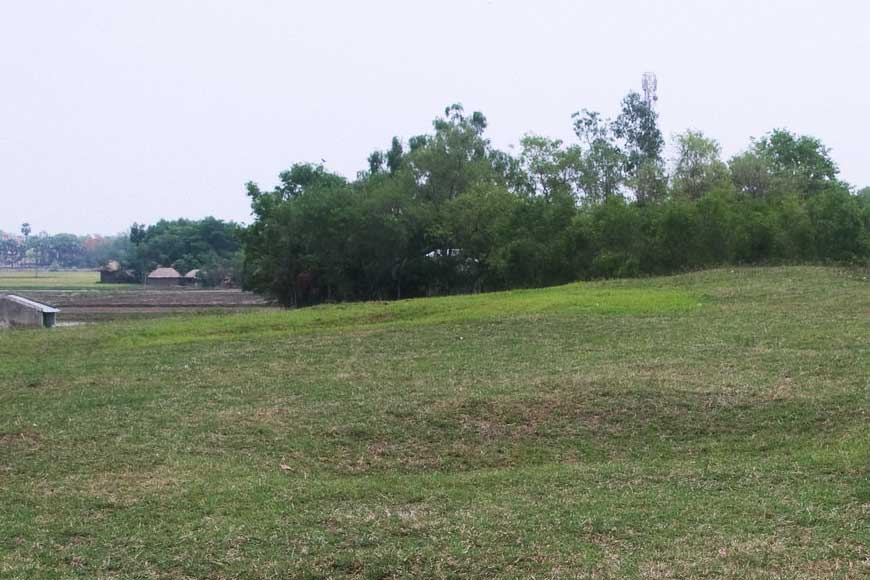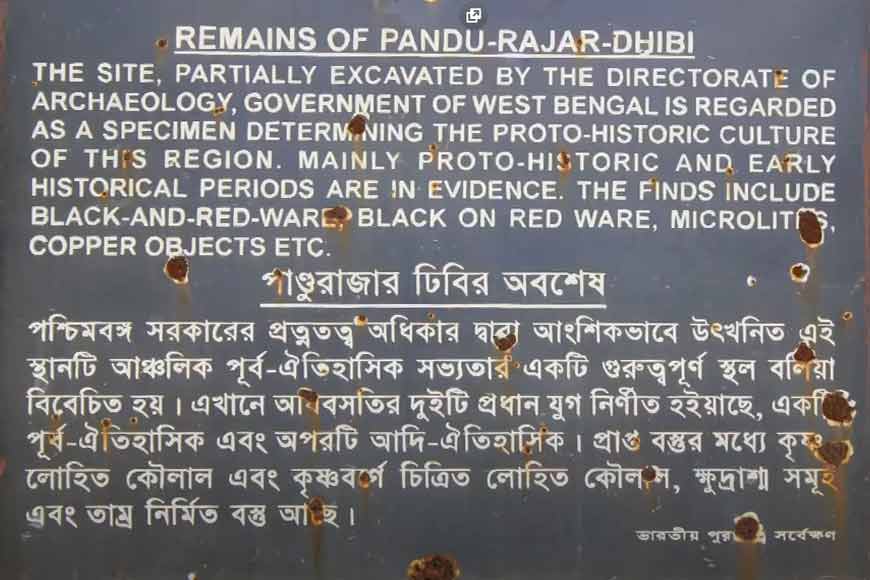‘Pandu Rajar Dhipi’ – Bengal’s Chalcolithic site could be as old as the Harappan civilization!

Not far from Ausgram in East Burdwan stands a series of mounds that may appear to be non-descript at first sight, but none the less bear footprints of a rich archaeological site. ‘Pandu Rajar Dhibi’ of Ausgram II Block in the Sadar North subdivision of East Burdwan district was first unearthed in 1950s. The Archaeological Survey of India (ASI) had undertaken several excavation expeditions in this area and found the first Chalcolithic site of Bengal. Locals associate the central mound at Pandu Rajar Dhibi with King Pandu, the ruler of Kuru dynasty and father of the five Pandavas of the epic Mahabharata.
Later excavations in Bonkoti village, close to the Dhibi had revealed innumerable microlithic tools made of wood and crystal. While such artifacts of Neolithic and Chalcolithic era are commonly seen across the Raarbhumi (Birbhum and Burdwan) and the adjoining three districts, of Midnapore, Bankura and Purulia, the excavations at the Pandu Rajar Dhibi changed the course of studies into the pre-proto historic and ancient Bengal.

The ASI reports of 1962-65 and a later report on the site by M.K. Dhavalikar (1973) emphasized the importance of the Pandu Rajar site in the studies of proto-historic era Bengal. Yet, it is most unfortunate that the artefacts from the site were not taken up for further advanced studies and scientific analyses. However, local resident and founder-secretary of ‘Panduraja Pratnagobeshona Kendra (Panduraja Archaeological Centre), Radhamadhob Mondal, has been vocal and trying to preserve the rich heritage of the area. The findings have proved that the civilization that thrived here was parallel to the late Harappan Era. Mondal has been relentlessly sensitizing locals about the historical importance of the plot and devising ways to preserve the site wherein tools from the Stone Age era dating back to almost 20,000 years have been found.
Recently Mondal mobilized the residents and members of the Panduraja Archaeological Centre to take up cudgels against the ASI. Pandu Rajar Dhibi lies on the banks of Rasfalla pond in Ramnagar, which is locally known as Rajapota. Adjoining this site is Pandua village. Pareshnath Dasgupta began excavating this area way back in 1962 and work continued till 1965 in four phases. This was the time when the Naxal Movement was gaining ground. As political unrest escalated, the work was abandoned mid-way. In 1985, another attempt was taken to excavate the area but the half-hearted approach of the authorities yielded no concrete resolution. After this, a veil was cast over proto-historic and ancient Bengal.
A total of five excavation operations were undertaken which yielded rich dividends. Over 4,500 ancient artefacts were discovered which included 14 stone inscriptions and fossils of 11 human skeletons. Each of the skeletons were about 11 feet high which suggest they belonged to the Austrid race. The first ‘Kalash Samadhi’ in India was unearthed at this site. All the artefacts are haphazardly preserved in different museums and universities. The 1962-65 ASI excavations at the Pandu Rajar Dhibi revealed four layers of varying periods, of which Period III belongs to around 1000 BCE; Period II is said to belong to the 1012+-120 timeline; while Period I belongs to the earlier times of around 2000 BCE (if not earlier). In the 1964 excavation, various artefacts showed that the people living there knew the use of iron, and probably smelted at the site. A Seal and engraving revealed that a writing pattern of sharp linear pattern once existed in the 2nd millennium BCE in the area around the Ajay valley.
Mondal and his team plan to place their charter of demands which include proper maintenance of the site by ASI and publishing of the reports submitted by archeologists Pareshnath Dasgupta, Dr Debkumar Chakraborty, Shyamchand Mukherjee and world renowned archaeologists Dr Y.D. Sharma, Hanslal Dheerajlal Sankhalia, Dr B.B. Lal and others who had carried out excavation work at the site from time to time. Today not many people (including those that live in the nearby districts) know the name of the site; leave aside being aware of its historical importance. In fact, most Bengalis are not even aware of their rich heritage that once ran parallel to the late Harappan era.










